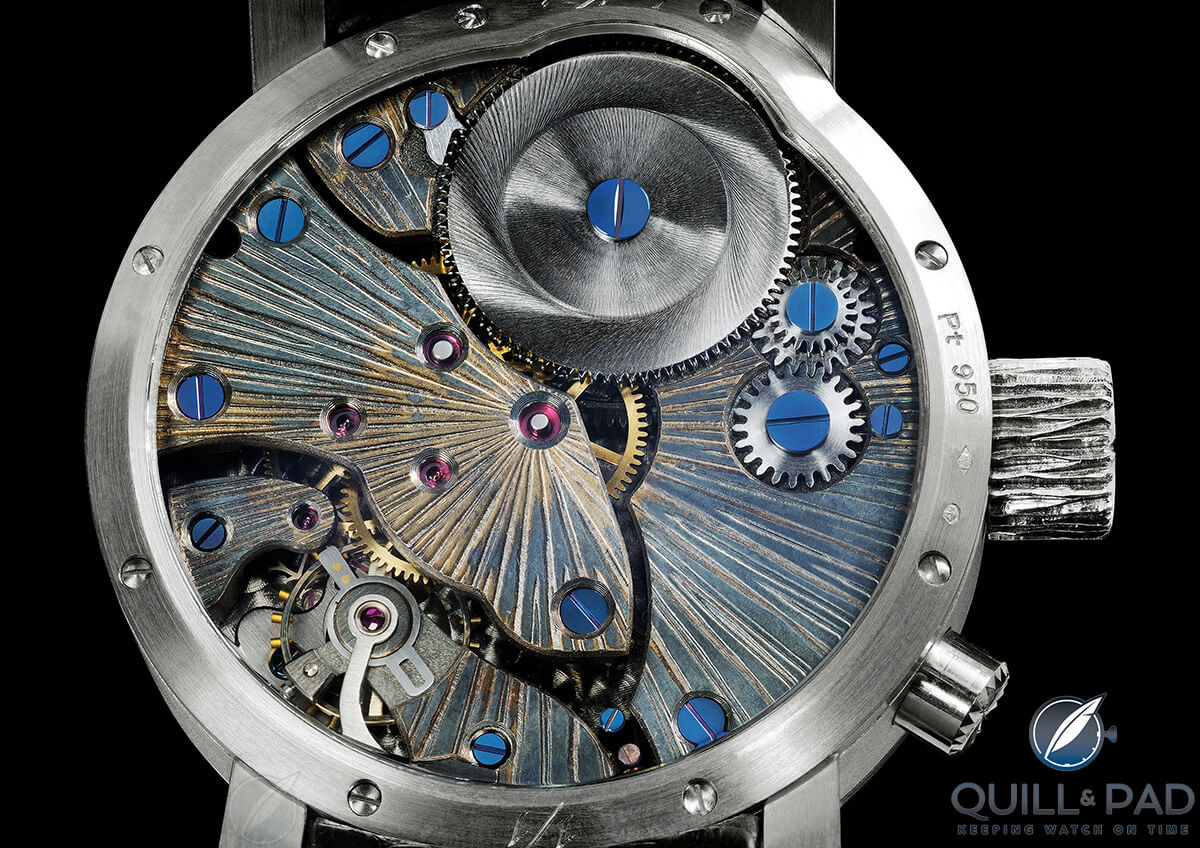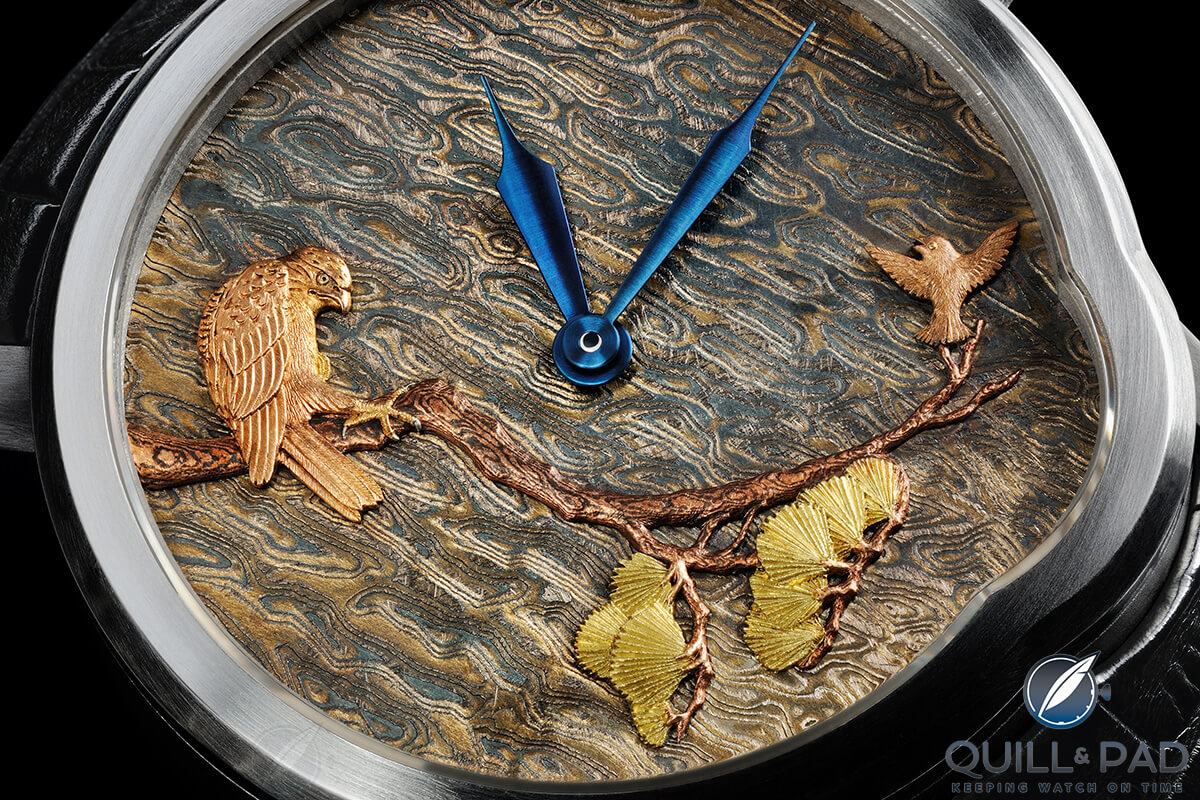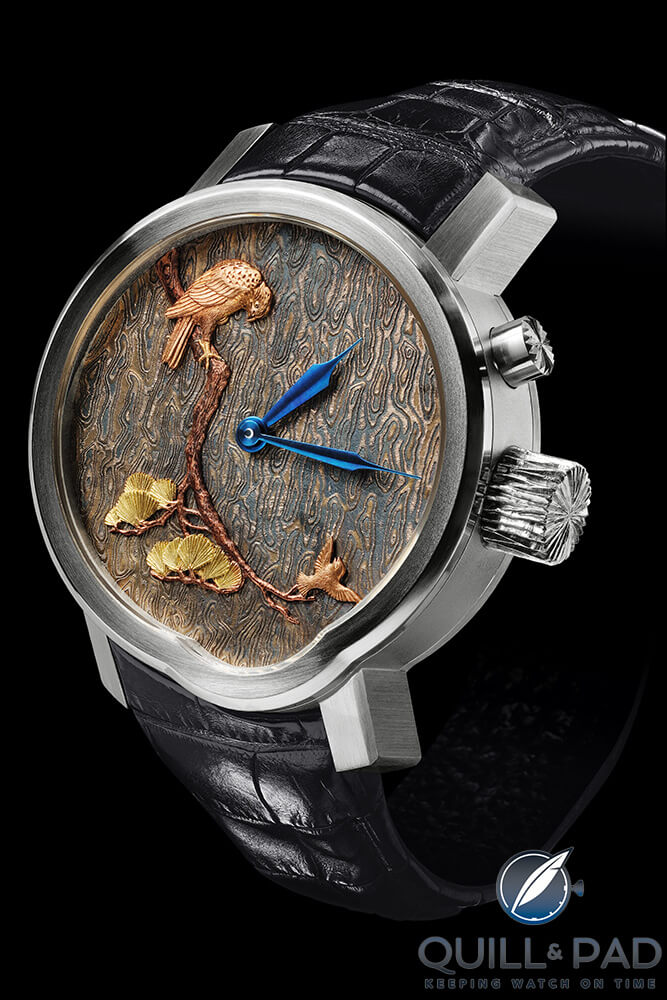The first thing that probably hit you in the title of this post is the word “tsuba.” This needs a bit of explanation.
A tsuba is the hand guard of a traditional Japanese sword. “These eventually became elaborate pieces of art – far beyond their practical use,” says engraver Kees Engelbarts, whose fascination with Japanese handcrafts led him to be the first to use mokume gane – a wood-grain-like metal layering technique – in watchmaking.
The dial of Engelbarts’ Tsuba watch depicts a scene featuring a hawk and sparrow that was inspired by a copper-and-silver tsuba created by Japanese swordsmith Hamano Masanobu in approximately 1836. A hawk, perched at the top right on a branch, looks down at a sparrow at lower left.

The inspiration for Kees Engelbarts’ Tsuba watch is this tsuba made by Hamano Masanobu in 1836 (photo courtesy Wikipedia)
While the original tsuba that served as inspiration for this veritable piece of mechanical art is now on exhibition in the Walters Art Museum in Baltimore, Maryland, one fortunate watch collector can own Engelbarts’ inspired interpretation.
Engelbarts used a variety of different materials to make the dial: the hawk is in red gold; the branch is in his beloved mokume gane alloyed in pink gold and shakudo (a Japanese alloy); the leaves are green gold; and the little sparrow is made of bronze.
The rare art of mokume gane, which Engelbarts introduced to the Swiss watch industry, is manufactured by bonding two non-ferrous metals with compatible properties of ductility and malleability. This can be achieved using up to five colored metals, although Engelbarts only uses precious metals such as pink, white, and yellow gold, silver, and shakudo.
Ten to twenty layers of metal are generally used to produce a sheet of mokume gane, and Engelbarts usually forms his from nineteen separate layers. Starting with a bar approximately one centimeter in thickness, the metals are fusion-layered (without the use of solder) and laminated into a plate 0.4 mm in thickness that Engelbarts uses to create a dial.

A close look at the sculptured sparrow on the dial of Kees Engelbarts’ Tsuba watch (photo courtesy Guy Lucas de Peslouan)
A new molecular structure is created between the layers, transforming it into one homogenous mass, and Engelbarts also heats the piece in between every new turn through the rolling mill to avoid the layers separating. The patterns that appear like wood graining are topographical and cannot be predicted, although a specific desired pattern can be anticipated by drilling holes into the metal before laminating.
Each piece of mokume gane is different, and each watch dial created from this unique fusion of metals is one-of-a-kind.
This dial’s smallest details are also created in the interesting and varied manner that is Engelbarts’ signature – such as the hawk, whose eye and feet are in yellow gold with silver accents for the pupil and claws. The eye of the sparrow is also yellow gold.

A close look at the sculptured hawk on the dial of Kees Engelbarts’ Tsuba watch (photo courtesy Guy Lucas de Peslouan)
All dial elements have been cut, shaped, positioned, and soldered together by hand. Once assembled, Engelbarts engraves the pieces using bas-relief technique to provide a three-dimensional effect that is obvious when observing the scene from various angles. Some elements have been heated and /or chemically treated in order to modify the coloring and provide the entire scene with a distinctive antique-like atmosphere.
The base plate upon which the scene is mounted comprises white gold/silver mokume gane that has been treated with nitric acid. This acid attacks the silver and leaves the white gold unchanged, accentuating the relief structure. The hands are crafted in tempered blue stainless steel, while Engelbarts has fashioned the unusual crown that looks like a piece of wood out of mokume gane.

View through the display back to the richly decorated vintage AS 690 caliber of Kees Engelbarts’s Tsuba watch (photo courtesy Guy Lucas de Peslouan)
The vintage AS 690 8-day movement from 1935 that Engelbarts chose to power the timepiece is large and robust. Mechanically, it is also interesting as it includes a leaf spring shock absorber not unlike Abraham-Louis Breguet’s pare-chute system. The unique positioning of the movement’s spring barrel is mirrored in the shape of the generously sized 49 mm platinum case.

A close look at the sculptured branches and leaves on the dial of Kees Engelbarts’ Tsuba watch (photo courtesy Guy Lucas de Peslouan)
It has likewise been decorated with white-gold-and-silver mokume gane, whose unusual pattern spreads like a star from the center. The screws are hand-polished, beveled, and tempered blue.
Engelbarts needed several months to complete this watch, which is a unique piece that will go to one very lucky collector with excellent taste.
For more information, please visit www.kees.ch.
Quick Facts
Case: 49 x 16.3 mm, platinum, shaped with protrusion at 5 o’clock to accommodate the vintage movement’s generous spring barrel, pusher at 2 o’clock for time-setting
Movement: hand-wound vintage AS 690 from 1935 with 8 days’ power reserve, 2.5 Hz/18,000 vph
Dial: hand-engraved and treated gold, silver, mokume gane, and bronze
Functions: hours, minutes
Limitation: one unique piece
Leave a Reply
Want to join the discussion?Feel free to contribute!




Hi, could I ask how much the mokumé gane watches are please?
Hi Kimberly,
Most timepieces Kees Engelbarts makes are unique-piece commissions, so there is no “set price.” You can expect pricing upwards of $30,000 USD, though. For any further information, I do urge you to contact Kees directly: http://www.kees.ch/index.php/get-in-touch